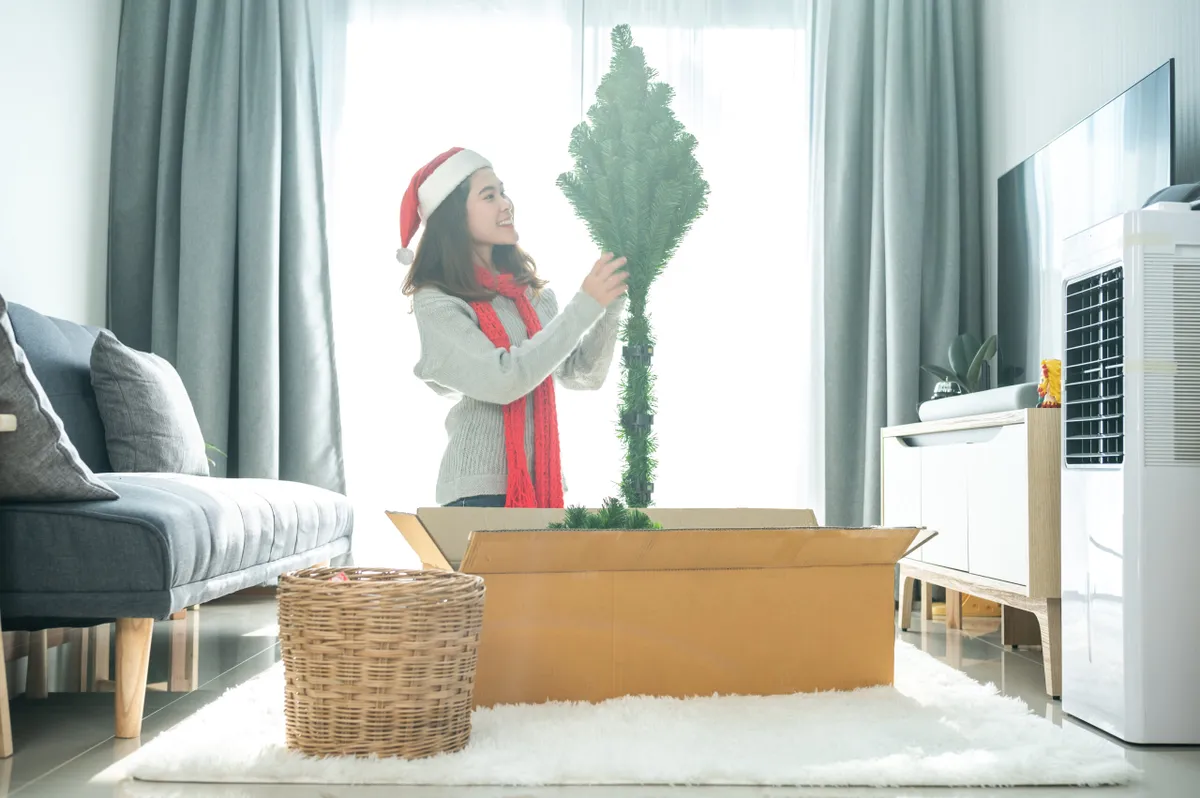Christmas wouldn’t be Christmas without a Christmas tree. But what is the most sustainable Christmas tree option? The real tree versus fake Christmas tree debate continues, and there are no clear-cut answers. Is it better to bring down an artificial tree from the loft every year, or is it more environmentally friendly to buy a freshly cut tree, as many of us do? The British Christmas Tree Growers Association estimates that around seven million of us buy a real Christmas tree every year.
We looked into the issue in a bid to find the most environmentally friendly Christmas tree.

Real or fake Christmas tree: which is more environmentally friendly?
The answer to this question depends on the specific Christmas tree that you choose (real trees can be cut, potted, or container-grown, as explained in our Christmas tree buying guide), how your tree is transported, your plans for reusing it and the way in which it is disposed of.
Real Christmas trees – pros and cons
The British Christmas Tree Growers Association points out that the majority of Christmas trees that we buy in the UK are grown in dedicated fields and on Christmas tree farms in the UK, and are treated like a crop – they are not felled from existing forests. It also points out that once a tree is cut down, it is replaced with a new seedling. A Christmas tree can take around 10 years to grow to a height of six feet. During that time, it can provide a home for wildlife, especially birds, and absorbs carbon from the atmosphere. While the vast majority of Christmas trees are farmed on arable land, it could arguably be put to better use - for growing food, for example, or creating some native woodland.

However, not all real, farmed Christmas trees are equal, and there are several factors to consider when buying one:
- Transportation can add to the carbon footprint of your tree, so try to buy one that is as local as possible to you.
- The use of fertiliser can also affect a tree's carbon footprint. The Carbon Trust advises buying a tree that is slow grown, with minimal or no fertiliser – buy from an organic retailer if you can.
- Plastic mesh – if you buy a cut Christmas tree from a garden centre, bear in mind that it will likely have been wrapped in plastic mesh on its way to the garden centre, and will then be wrapped in plastic again for you to take it home again. If you can, avoid getting your tree wrapped.
- Disposal – the way in which you dispose of your tree is very important – if your tree ends up in landfill, it will decompose and produce methane gas, which is ten times more potent than carbon dioxide.
How to dispose of your Christmas tree responsibly
Local authorities often offer a Christmas tree collection service. You can also shred your own tree using a shredder. The chips can be used as a mulch around the garden, or can be added to your compost bin. Burning your Christmas tree in a log burner or wood burning stove is a good way to dispose of a used Christmas tree and can reduce carbon emissions dramatically. Do not dump your Christmas tree on the street or in landfill.
Our advice: A pot-grown or container-grown tree can be used year after year, making it a sustainable option. You can also rent a Christmas tree locally. If you buy a cut tree, make sure that you recycle it with your local council, shred it or burn it in a log burner.
Read our advice on buying a real Christmas tree and our ideas for alternative Christmas trees – conifers that can be grown in pots.
Fake Christmas trees – pros and cons
Most artificial Christmas trees are made in China. They are made from plastic, metal and PVC and burn fossil fuels during their production. They are then shipped to the UK. As they are made from mixed materials, they can rarely be recycled.
According to the Carbon Trust, a 2m artificial tree made from plastic has a carbon footprint that is 10 times greater than that of a real Christmas tree. It estimates that a fake tree would need to be used between 7-20 times depending on its weight and the different materials used for its environmental impact to be lower than that of a real cut tree that is properly disposed of.
Our advice: If you already have an artificial tree, keep using it. If you are tempted to buy one, choose one that has a classic look, so that you're less likely to throw it away when it goes out of fashion. Use it for many, many years to come. Endeavour to recycle it if at all possible - or pass it on for someone else to enjoy.
Our verdict: are real or fake Christmas trees more sustainable?
On balance, it could be best to buy a real, container-grown Christmas tree that can spend most of the year outdoors, coming inside for the festive season every year. If you're short on outside space, rent a real container-grown Christmas tree locally.
If you do buy a cut tree, dispose of it carefully afterwards by recycling it with your local council, chipping it into mulch, or burning it in a log burner.
If you would still prefer to buy an artificial tree, source it carefully and use it for as many years as possible.
Don't miss our Christmas hub page for all our festive content